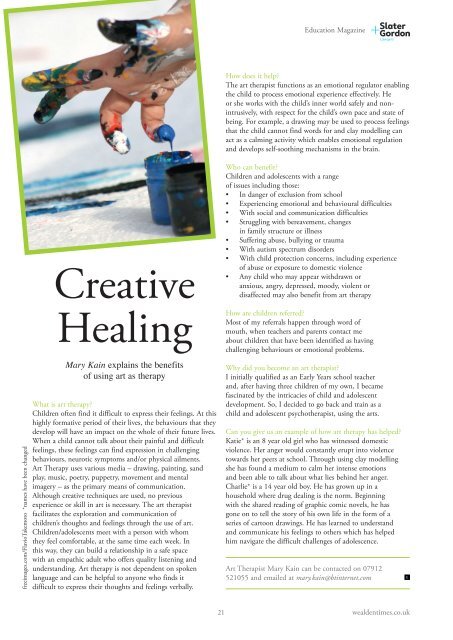Create successful ePaper yourself
Turn your PDF publications into a flip-book with our unique Google optimized e-Paper software.
<strong>Education</strong> Magazine<br />
How does it help?<br />
The art therapist functions as an emotional regulator enabling<br />
the child to process emotional experience effectively. He<br />
or she works with the child’s inner world safely and nonintrusively,<br />
with respect for the child’s own pace and state of<br />
being. For example, a drawing may be used to process feelings<br />
that the child cannot find words for and clay modelling can<br />
act as a calming activity which enables emotional regulation<br />
and develops self-soothing mechanisms in the brain.<br />
freeimages.com/FlavioTakemoto *names have been changed<br />
Creative<br />
Healing<br />
Mary Kain explains the benefits<br />
of using art as therapy<br />
What is art therapy?<br />
Children often find it difficult to express their feelings. At this<br />
highly formative period of their lives, the behaviours that they<br />
develop will have an impact on the whole of their future lives.<br />
When a child cannot talk about their painful and difficult<br />
feelings, these feelings can find expression in challenging<br />
behaviours, neurotic symptoms and/or physical ailments.<br />
Art Therapy uses various media – drawing, painting, sand<br />
play, music, poetry, puppetry, movement and mental<br />
imagery – as the primary means of communication.<br />
Although creative techniques are used, no previous<br />
experience or skill in art is necessary. The art therapist<br />
facilitates the exploration and communication of<br />
children’s thoughts and feelings through the use of art.<br />
Children/adolescents meet with a person with whom<br />
they feel comfortable, at the same time each week. In<br />
this way, they can build a relationship in a safe space<br />
with an empathic adult who offers quality listening and<br />
understanding. Art therapy is not dependent on spoken<br />
language and can be helpful to anyone who finds it<br />
difficult to express their thoughts and feelings verbally.<br />
Who can benefit?<br />
Children and adolescents with a range<br />
of issues including those:<br />
• In danger of exclusion from school<br />
• Experiencing emotional and behavioural difficulties<br />
• With social and communication difficulties<br />
• Struggling with bereavement, changes<br />
in family structure or illness<br />
• Suffering abuse, bullying or trauma<br />
• With autism spectrum disorders<br />
• With child protection concerns, including experience<br />
of abuse or exposure to domestic violence<br />
• Any child who may appear withdrawn or<br />
anxious, angry, depressed, moody, violent or<br />
disaffected may also benefit from art therapy<br />
How are children referred?<br />
Most of my referrals happen through word of<br />
mouth, when teachers and parents contact me<br />
about children that have been identified as having<br />
challenging behaviours or emotional problems.<br />
Why did you become an art therapist?<br />
I initially qualified as an Early Years school teacher<br />
and, after having three children of my own, I became<br />
fascinated by the intricacies of child and adolescent<br />
development. So, I decided to go back and train as a<br />
child and adolescent psychotherapist, using the arts.<br />
Can you give us an example of how art therapy has helped?<br />
Katie* is an 8 year old girl who has witnessed domestic<br />
violence. Her anger would constantly erupt into violence<br />
towards her peers at school. Through using clay modelling<br />
she has found a medium to calm her intense emotions<br />
and been able to talk about what lies behind her anger.<br />
Charlie* is a 14 year old boy. He has grown up in a<br />
household where drug dealing is the norm. Beginning<br />
with the shared reading of graphic comic novels, he has<br />
gone on to tell the story of his own life in the form of a<br />
series of cartoon drawings. He has learned to understand<br />
and communicate his feelings to others which has helped<br />
him navigate the difficult challenges of adolescence.<br />
Art Therapist Mary Kain can be contacted on 07912<br />
521055 and emailed at mary.kain@btinternet.com<br />
21 wealdentimes.co.uk


















